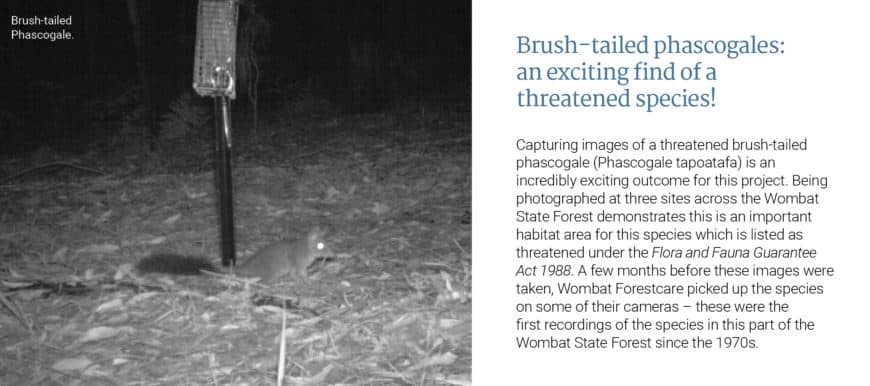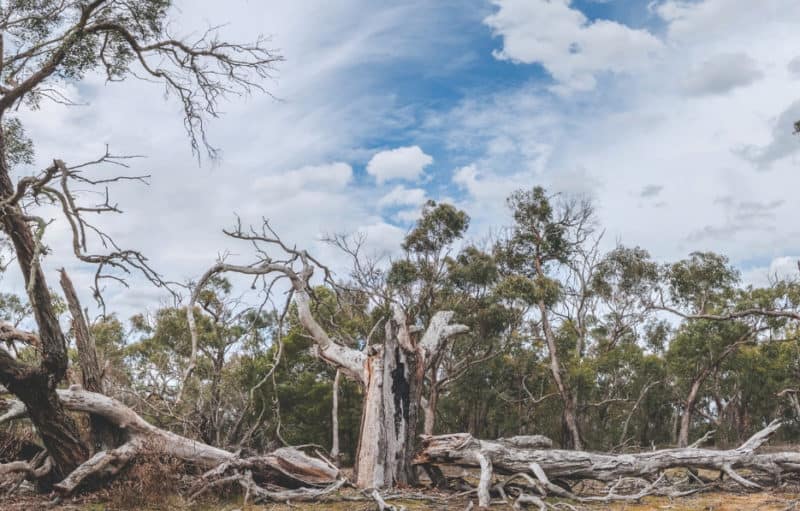PARK WATCH June 2019 |
Our Naturewatch program’s Coordinator Sera Blair shares the tremendous halfway results of our Caught on Camera project.
One of the reasons we love Wombat Forest and want to see it better protected as a national park is that we have spent a lot of time there enjoying the forest and conducting citizen science.
Between 2012 and 2016 more than 200 volunteers contributed over 2,500 hours to monitor wildlife in Wombat State Forest as part of our NatureWatch citizen science program’s Caught on Camera project.
This is part of a ten-year project, and VNPA has just released a report of the findings at the five-year halfway mark.
Caught on Camera has been a significant achievement for the local and wider community. Through the project, we’ve built and strengthened positive and long-lasting links between the community, scientists and government. The community came together to develop and deliver this project with volunteers from Wombat Forestcare and VNPA’s NatureWatch program.
The first five years of this inspiring citizen science effort amassed highly valuable data on 13 native mammal species and 15 native bird species (including threatened species). We also recorded nine introduced mammal species and one introduced bird species.
Native mammals: Echidna, brush-tailed phascogale, agile antechinus, dusky antechinus, common brushtail possum, mountain brushtail possum, common ringtail possum, koala, common wombat, black wallaby, eastern grey kangaroo, bush rat, swamp rat.
Black wallabies were the most commonly detected species, photographed on all 44 research sites, and recorded on more days than any other species. The next most common mammal species, in terms of the number of sites recorded on, were common wombat (36 sites), agile antechinus (31), introduced red fox (28), mountain brushtail possum (26), eastern grey kangaroo (22), and bush rat (18). the two small species in the group, agile antechinus and bush rat, were recorded on more days at each site than the larger species, reflecting their small home ranges and consequently higher density.
An exciting finding was of brush-tailed phascogales, a threatened species listed under Victoria’s Flora and Fauna Guarantee Act 1988. This study adds to previous results by Wombat Forestcare to document their distribution in the southern part of the Wombat Forest, whereas they were formerly only known in the drier northern area. Phascogales were caught on camera at three sites, demonstrating this is an area of important habitat for them and showing that they make use of widely distributed less threatened habitats like Foothill Forests.
Native birds: Southern boobook, laughing kookaburra, crimson rosella, superb fairy-wren, white-browed scrubwren, spotted quail-thrush, grey shrike-thrush, grey currawong, pied currawong, Australian magpie, white-winged chough, scarlet robin, flame robin, eastern yellow robin, bassian thrush.
The most commonly detected bird species was the superb fairy-wren (20 sites) followed by the grey shrike-thrush (18 sites).
Camera trap monitoring focusses on animals that come to the ground, that are primarily ground-dwelling or ground-foragers. Therefore, no gliders or bats were recorded by the cameras which are located at ground level. However, Wombat Forestcare has observed greater gliders on many sites.
Introduced mammals recorded include: Red foxes, black rat, house mouse, European rabbit, brown hare, feral goat, sambar deer, cat, dog.
Foxes were common across sites and generally were only photographed a few times in a sequence. They seem to move quickly through an area and may have been aware of the cameras – as evident in many photos showing them looking directly at the cameras.
What the findings mean
This study looked at the presence of native species in relation to the type of ecological vegetation class of the forest, and fire history.
Three of the less common native mammals recorded were only found in Foothills Forest: brush-tailed phascogale, swamp rat and dusky antechinus. Fewer birds were recorded in the two sites containing Grassy/ Heathy Dry Forest than in sites containing Forby Forest or Foothills Forest.
With regards to fire history, there is a marked difference in species presence directly after fire, particularly in the first three years. After that, the effects of fire on flora and fauna are generally subtler as their ecosystem recovers. This research, with sites selected to represent areas burnt at different time intervals, saw the same trend, corroborating the findings of other recent studies.
Moving forward, we will continue this fantastic community effort and continue monitoring the wildlife in the Wombat State Forest. Partnerships that have been forged have enabled the success of this citizen science project, and we hope to continue the effort and build on these for more years. Cameras are currently in the field, rotated by volunteers every three weeks.
Wombat is one of several forests in Victoria recommended to be better protected by creating new national parks in the central west of the state. We need to strongly encourage the State Government to commit to and implement these recommendations by the Victorian Environmental Assessment Council (VEAC). Please send them your message today.
What is Caught on Camera?
Motion-sensing cameras provide an alternative fauna monitoring method to traditional survey techniques (e.g. trapping, spotlighting) that are more labour-intensive and stressful for the animals.
Each March to July more than 45 volunteers set up cameras at up to 20 sites to automatically detect and record species throughout the day and night. In five years, 44 sites have been selected and surveyed across the Wombat State Forest study area.
The project has seen passionate community members, scientists and managers working together to increase our understanding of mammals in Wombat Forest. The project has expanded the skills and knowledge of everyone involved.
The project is a terrific opportunity for engagement — the photographs of animals ‘Caught on Camera’ in their natural environment can be shared throughout the community as well as to a wider audience online. This can serve as an educational tool and inform the community about the richness of their local environment, fostering a more meaningful relationship between the community and the place in which they live.
“Participation has broadened my knowledge and appreciation of local plants and animals and the habitats in which they live.”
“Community members have a desire for ecological knowledge and their participation allows for the sharing of this knowledge.”
You can get involved in Caught on Camera here.
Did you like reading this article? Want to be kept up to date about this and other nature issues in Victoria? Subscribe to our email updates.
You can also receive our print magazine Park Watch four times a year by becoming a member. Find out more here.

